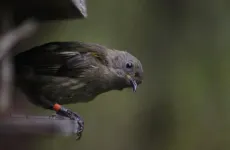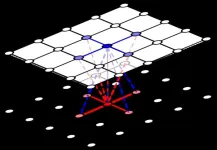(Press-News.org) An invasive, freshwater jellyfish is popping up in B.C. waters in the thousands and future sightings could increase rapidly, according to UBC research.
The peach blossom jellyfish clones have been spotted in 34 places in B.C., its furthest northern range in North America, and a recent paper predicts sightings and the number of locations will increase by the end of the decade as climate change extends this range.
Dr. Florian Lüskow, who completed the research during his postdoctoral fellowship at UBC’s department of earth, ocean and atmospheric sciences (EOAS), and Dr. Evgeny Pakhomov, professor in EOAS and the Institute for the Oceans and Fisheries (IOF), discuss the mysterious jelly.
What do we know about these jellyfish?
FL: This is an introduced jellyfish species from China which has spread around the world. We know very little about how they affect ecosystems and biodiversity of these systems in Canada, because the research hasn’t been done yet. The worry is that they harm indigenous species by outcompeting them. We’re the only researchers in Canada investigating these jellyfish, with help from citizen scientists around B.C.
Peach blossom jellyfish have been reported in B.C. since 1990, mainly in the Lower Mainland, on Vancouver Island, around the Sunshine Coast and more recently, as far inland as Osoyoos Lake. Between 1990 and 2023, a 34 year span, there have been 85 sightings, counted once per location per year, where each sighting could be one or thousands of jellyfish. But in this decade alone, we are predicting about 80 sightings, and likely in more than the 34 locations currently observed.
We know that of the 100 jellyfish examined so far, each has been male comprised of the same genetic material, which means these thousands of jellyfish are effectively clones and originated from the same polyp or a small cluster of polyps—the stage of a jellyfish which lives at the bottom of a body of water.
EP: Polyps are very small, usually around a millimetre in size, and it is challenging to locate them. They inhabit shallow areas and can be found on rocks and submerged wood debris. Hence, we usually know about jellyfish introduction when we see the floating medusa form produced by polyps appear in the water, which appear only when water temperature is higher than 21 degrees Celsius —so polyps could be in many more lakes without us knowing about it. We do not know how and when introduction of the species occurred, but it was likely through medusa-producing polyps carried on recreational boats or on the bills or feet of birds when feeding.
We found medusae in ponds, quarries and lakes, but never in creeks or rivers. And, we know that the jellyfish aren’t harmful to humans, because their stings can’t pierce human skin.
How is climate change affecting these jellies?
FL: B.C. is the northernmost point in this continent for the peach blossom jellyfish’s range. It relies on mild winters and high summer temperatures to reproduce, so we wouldn’t see them in the Prairies because the winters are too cold.
EP: If climate change leads to freshwater temperature increases across B.C., we will likely see wider spread. Modelling indicates that even Alaskan reservoirs may potentially see invasion. However, there is a silver lining: So far only males, which are genetically identical, have been observed. This means that the jellyfish cannot complete their sexual reproduction and thus its adaptation to new environments will be limited. This would curtail their spread.
What are the next steps?
EP: The priority should be two-fold: first, to properly map the actual distribution of the peach blossom jellyfish, including range, in B.C. Second, to better quantify the jellyfish impact on freshwater ecosystems, including young salmon.
FL: To achieve the first objective, we’d like to use environmental DNA, which is a tool that ascertains the DNA in a sample of water. This would allow us to find out if the jellyfish is present even if we can’t see it, say, in its polyp form.
We’d also like to receive observations wherever they occur. People who spot a peach blossom jellyfish can submit a report to iNaturalist, the Invasive Species Council of BC, or to us.
This would help us answer fundamental questions about the jellyfish and its impact on B.C. ecosystems and species, allowing better informed management recommendations.
END
Thousands of jellyfish clones are multiplying in B.C. lakes
2024-09-03
ELSE PRESS RELEASES FROM THIS DATE:
Infertility challenges amongst endangered wild songbird population revealed in new study
2024-09-03
A new study using 10 years of data has provided the most comprehensive estimate of infertility rates to date in a threatened wild animal population
Researchers from the University of Sheffield found infertility accounts for 17 per cent of hatching failure in an endangered songbird, the hihi, with the majority of hatching failure being caused by embryo death
This is the first study to find a link between small population size, sex ratio bias, and reduced fertilisation rates in wild animals
By considering the impacts of population size and sex ratio on fertility, conservationists can better manage the numbers and composition of animals in populations ...
Representatives from NASA, ESA, JAXA, ASI, KASA meet during COSPAR 2024 to reinforce cooperation and coordination for future missions to the asteroid Apophis
2024-09-03
Each agency representative presented the status of their current involvement in current and future planning for missions to Apophis (including extended mission for OSIRIS-REx, renamed OSIRIS-APEX, for NASA and the RAMSES mission for ESA) as well as the existing partnerships and mutual involvement in other agency’s missions, e.g. the infrared camera provided by JAXA in ESA’s mission Hera. Concepts to fly to Apophis, as well as reuse of existing payloads, spare parts and hardware, coordination of arrival time at Apophis of the different spacecraft, techniques to be demonstrated, ...
Vision-based ChatGPT shows deficits interpreting radiologic images
2024-09-03
OAK BROOK, Ill. – Researchers evaluating the performance of ChatGPT-4 Vision found that the model performed well on text-based radiology exam questions but struggled to answer image-related questions accurately. The study’s results were published today in Radiology, a journal of the Radiological Society of North America (RSNA).
Chat GPT-4 Vision is the first version of the large language model that can interpret both text and images.
“ChatGPT-4 has shown promise for assisting radiologists in tasks such as simplifying patient-facing radiology reports and identifying ...
Minimal ADHD risk from prenatal cannabis use new study reveals
2024-09-03
A new study reveals nuanced findings on the neuropsychiatric risks of prenatal cannabis exposure. The research found a slight increase in the risk of ADHD and a heightened vulnerability to cannabis use in offspring. These results highlight the need for continued caution and further investigation into the long-term effects of cannabis use during pregnancy.
A new study led by Prof. Ilan Matok and Hely Bassalov PharmD from the Department of Clinical Pharmacy at the School of Pharmacy in the Faculty of Medicine at Hebrew University in collaboration ...
Study suggests gun-free zones do not attract mass shootings
2024-09-03
Gun-free zones have often been blamed for making schools, malls and other public areas more attractive to shooters; however, there have been no quantitative studies examining those claims. Now, in a first of its kind study published in The Lancet Regional Health Americas, researchers at UC Davis Health and other institutions have shown that gun-free zones may, in fact, reduce the risk of mass shootings.
"Our most significant finding is that gun-free zones don't attract active shooters,” said the study’s first author, Paul Reeping, ...
Mathematicians model a puzzling breakdown in cooperative behaviour
2024-09-03
Darwin was puzzled by cooperation in nature—it ran directly against natural selection and the notion of survival of the fittest. But over the past decades, evolutionary mathematicians have used game theory to better understand why mutual cooperation persists when evolution should favour self-serving cheaters.
At a basic level, cooperation flourishes when the costs to cooperation are low or the benefits large. When cooperation becomes too costly, it disappears—at least in the realm of pure mathematics. ...
Kessler Foundation scientists publish protocol for combining aerobic exercise and cognitive rehabilitation in multiple sclerosis
2024-09-03
East Hanover, NJ – September 3, 2024 – Researchers at Kessler Foundation have published a new clinical protocol examining the combination of aerobic exercise and cognitive rehabilitation to improve learning and memory in individuals with multiple sclerosis (MS) who have mobility disability. The article, “Rationale and methodology for examining the combination of aerobic exercise and cognitive rehabilitation on new learning and memory in persons with multiple sclerosis and mobility disability: Protocol for a randomized controlled trial,” was published online and will appear in print in Contemporary Clinical Trials, ...
New hope for progressive supranuclear palsy with innovative trial
2024-09-03
$75 million NIH grant could lead to the first effective drugs for a condition with few treatment options
A clinical trial that will test three drugs concurrently, and could include more, represents new hope for patients with progressive supranuclear palsy (PSP), an incurable neurodegenerative disorder that usually kills within seven years after symptoms start.
Researchers hope the trial, which will be led by UC San Francisco and conducted at up to 50 sites nationwide, will lead to the development of new therapies. There are currently no drugs to stall the disease’s deadly progression.
The ...
Mass General Brigham Gene and Cell Therapy Institute launches RNA Therapeutics Core
2024-09-03
The Mass General Brigham Gene and Cell Therapy Institute (GCTI) today announced it has launched the RNA Therapeutics Core, a first-of-its-kind, state-of-the-art facility and resource to advance the use of RNA technologies within and beyond the Mass General Brigham research ecosystem. This new Core is dedicated to accelerating the exploration of novel therapeutic targets to effectively translate RNA-based medicines into clinical practice by leveraging advanced RNA vectors and delivery systems.
Until now, a Core of this kind has not existed within an academic setting. With this launch, the RNA Therapeutics Core enables ...
Dangerous airborne fungus boosted by California droughts
2024-09-03
Valley fever is an emerging fungal disease in the western United States that most often causes flu-like symptoms, but can also cause dangerous or even deadly complications. By analyzing data on reported cases of Valley fever in California, which have increased dramatically over the last two decades, researchers from University of California San Diego and University of California, Berkeley, have identified seasonal patterns that could help individuals and public health officials better prepare for future surges in Valley fever cases. The findings also have important implications for how the changing climate can exacerbate the threat of infectious diseases. The findings are published in The ...




